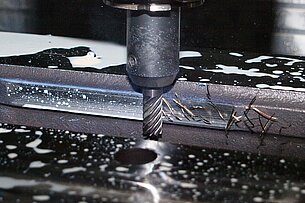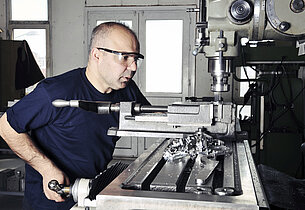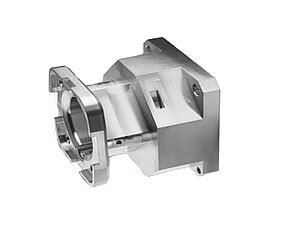Fixtures for milling
For manufacturing, some companies use so-called fixtures.
Through these, companies can ensure a process with reproducible and high quality.
What is meant by the term "fixture"? What are the advantages and disadvantages of this type of manufacturing support?
And what is the relevance for the production of milled parts?
A fixture is a technical aid for series production or small series production. It is linked to the workpiece and is related to machining, assembly or auxiliary processes that are necessary for production. Fixtures are used to position workpieces, hold them in place, clamp them and sometimes also to guide the tool. In other words, they are aids to ensure quality and to make work easier.
It is important to consider the interaction. This exists between the clamping force, the workpiece and the clamping device and must not push the fixed position and orientation of the workpiece out of the permissible limits before and during machining.
Uncontrolled deviations from the nominal position would result in a production error. Fixtures can be divided into clamping fixture, positioning fixture and fixture for gluing. The clamping device can minimise the effort, as it positions and clamps the workpiece. If this is matched to the process, set-up and working times and wastage can be reduced. The positioning device brings and holds the workpiece in the previously defined position. The device works differently for gluing, which "only" holds the workpiece until the applied glue has dried.
For example, there are position-determining elements that hold the workpieces and determine their position so that no alignment of the workpieces is necessary. The clamping elements amplify the force and pass it on to the auxiliary clamping elements, which transfer it to the workpiece.
The fixture body is the carrier of the clamping and determining elements of a fixture and forms the connection to the machine table.
When using a clamping fixture, the following sub-functions run in chronological order, which the operator must observe. First comes the one-time positioning and securing of the fixture on the machine table. Here the tool is set up for the workpiece. Next, the workpiece is placed in the fixture and a determination and positioning of the workpiece takes place (checking the determination position). Then the machining and cutting can begin. Finally, the workpiece is removed from the fixture and chips are removed from the fixture and the fixture is cleaned.
Considerable advantages of fixture construction lie in the technology. Fixtures can be used in both NC and CNC-controlled machine tools.
Even if changes are made to the workpiece, adjustments can quickly be made to the fixture. Another advantage of fixture construction is the quick use in case of unforeseen re-production of a workpiece. Furthermore, fixtures ensure high accuracy and dimensional stability during machining, which is reflected in the quality of the components. They shorten auxiliary times for aligning, clamping and measuring and ensure that ancillary work such as marking, punching and fitting is no longer necessary. Furthermore, clamping fixtures ensure short auxiliary times for setting, clamping and measuring. They reduce the reject rate and make better use of the processing machine through time overlap. Furthermore, the use of fixtures makes it possible to reduce the physical use of the pavers. This leads to a significant reduction in workload.
However, in addition to the advantages mentioned, there are also some disadvantages in fixture construction. One of these disadvantages is the cost factor. The purchase costs of the kit are quite high and the component storage and assembly space costs also add up. Another important aspect that needs to be taken into account and falls into the area of cost aspects is the capital commitment. Since the equipment is available in the companies, it represents a commitment of capital if it is not used regularly. In addition, if it is not used regularly, there is a risk of damage, such as the formation of rust. Another negative aspect of a fixture, falls under the realm of technology. For example, the weight and the amount of volume are usually greater than with special fixtures. Fixtures are limited in size and rigidity, so it is not possible, especially in flexible manufacturing systems, to allow the workpiece to be machined on all sides.
Milling is a machining process in which the milling tool moves and the workpiece is fixed. The tool moves through the workpiece and removes material via the X, Y and Z axes. The most common milling processes include thread milling, 3-axis milling, 5-axis milling and face milling. Milling is a subtracting process that is used in production engineering. Therefore, it is possible to use a fixture in this process. It is important for milling fixtures that the cutting forces should act against supporting elements of the fixture and that the force-transmitting parts of the fixture are very stiff so that no elements bend. Milling fixtures can be subdivided according to the "number of workpieces to be machined" or according to the "type of actuation of the clamping element". When subdivided according to the number of workpieces to be machined, a distinction can be made between a single milling fixture and a multiple milling fixture. When subdividing according to the type of actuation of the clamping element, a distinction can be made between manual milling devices,
Fixtures are used in machining to produce components, increasing flexibility and reducing non-productive time. A fixture has the task of positioning workpieces, holding them in position, clamping them and sometimes also guiding the tool. They provide work support for the finisher and can be used in NC and CNC controlled machines. With the help of a fixture, milled parts can be produced with high quality and less effort. However, the negative aspects must also be taken into account, as well as the positive aspects, when deciding whether to purchase a fixture.
Do you need turned or milled parts for your device? With us, you have the opportunity to confidently place your desired components in the hands of our CNC contract manufacturers. With our one-off or small batch production, we can ensure efficient manufacture of your fixture component. Submit an enquiry today.
Test our service!
Convince yourself of our uncomplicated service and make a production enquiry.
You will be surprised how little effort is required.
You can look forward to a high-quality prototype or a corresponding small series on the desired delivery date, which fully corresponds to your production drawing. Give it a try - it's worth it!


![[Translate to English:] PART FACTORY_Vorrichtung Fräsen [Translate to English:] PART FACTORY_Vorrichtung Fräsen](/fileadmin/_processed_/c/5/csm_milling-1359148_1280_caed32e51d.jpg)
![[Translate to English:] PART FACTORY_Fräsvorrichtung [Translate to English:] PART FACTORY_Fräsvorrichtung](/fileadmin/_processed_/2/3/csm_cnc-milling-machine-108584_1280_628cf7ac3b.jpg)
![[Translate to English:] PART FACTORY_Vorrichtungen in der Lohnfertigung [Translate to English:] PART FACTORY_Vorrichtungen in der Lohnfertigung](/fileadmin/_processed_/3/8/csm_PART_FACTORY_Vorrichtungen_in_der_Lohnfertigung_69a3f55a6e.jpg)
![[Translate to English:] PART FACTORY_Frästeil_6 [Translate to English:] PART FACTORY_Frästeil_6](/fileadmin/_processed_/a/8/csm_PART_FACTORY_Fraesteil_13_ad8b5f39be.jpg)
![[Translate to English:] PART FACTORY_Frästeil [Translate to English:] PART FACTORY_Frästeil](/fileadmin/_processed_/3/f/csm_PARTFACTORY_Fraesteil_914a42a525.jpg)





![[Translate to English:] PART FACTORY - Kontaktaufnahme [Translate to English:] PART FACTORY - Kontaktaufnahme](/fileadmin/_processed_/2/4/csm_woman-2773007__340_590260e0fe.jpg)